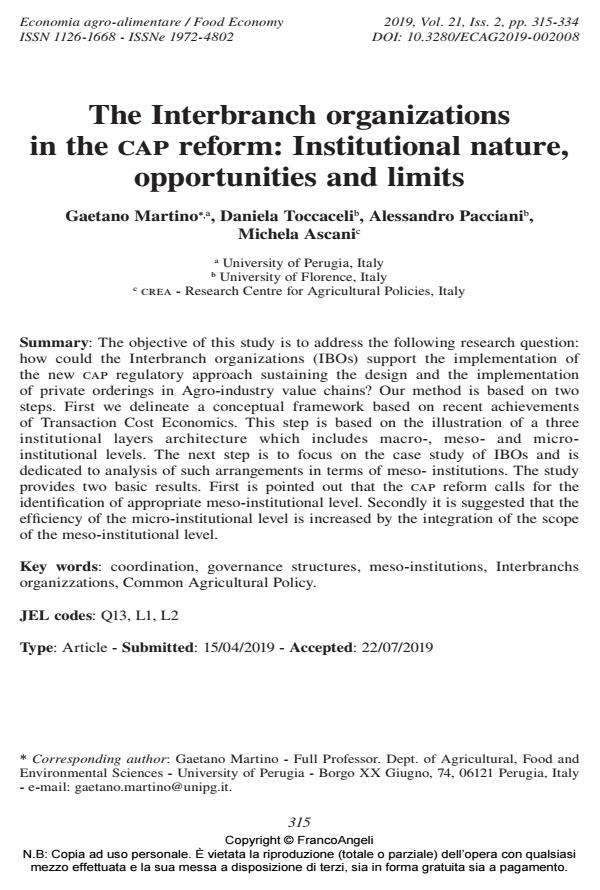The Interbranch organizations in the cap reform: Institutional nature, opportunities and limits
Journal title ECONOMIA AGRO-ALIMENTARE
Author/s Gaetano Martino, Daniela Toccaceli, Alessandro Pacciani, Michela Ascani
Publishing Year 2019 Issue 2019/2
Language English Pages 20 P. 315-334 File size 154 KB
DOI 10.3280/ECAG2019-002008
DOI is like a bar code for intellectual property: to have more infomation
click here
Below, you can see the article first page
If you want to buy this article in PDF format, you can do it, following the instructions to buy download credits

FrancoAngeli is member of Publishers International Linking Association, Inc (PILA), a not-for-profit association which run the CrossRef service enabling links to and from online scholarly content.
The objective of this study is to address the following research question: how could the Interbranch organizations (IBOs) support the implementation of the new cap regulatory approach sustaining the design and the implementation of private orderings in Agro-industry value chains? Our method is based on two steps. First we delineate a conceptual framework based on recent achievements of Transaction Cost Economics. This step is based on the illustration of a three institutional layers architecture which includes macro-, meso- and microinstitutional levels. The next step is to focus on the case study of IBOs and is dedicated to analysis of such arrangements in terms of meso- institutions. The study provides two basic results. First is pointed out that the cap reform calls for the identification of appropriate meso-institutional level. Secondly it is suggested that the efficiency of the micro-institutional level is increased by the integration of the scope of the meso-institutional level.
Keywords: Coordination, governance structures, meso-institutions, Interbranchs organizzations, Common Agricultural Policy.
Jel codes: Q13, L1, L2
- Governance in the Italian Processed Tomato Value Chain: The Case for an Interbranch Organisation Antonella Samoggia, Francesca Monticone, Gianandrea Esposito, in Sustainability /2022 pp.2749
DOI: 10.3390/su14052749 - Importance of different policy instruments in the introduction of sustainable innovation in fruit and vegetable value chains: The perception of coordinators of European research and innovation projects Riccardo Borgia, Matteo Zavalloni, Davide Viaggi, in Journal of Rural Studies 103695/2025 pp.103695
DOI: 10.1016/j.jrurstud.2025.103695
Gaetano Martino, Daniela Toccaceli, Alessandro Pacciani, Michela Ascani, The Interbranch organizations in the cap reform: Institutional nature, opportunities and limits in "ECONOMIA AGRO-ALIMENTARE" 2/2019, pp 315-334, DOI: 10.3280/ECAG2019-002008